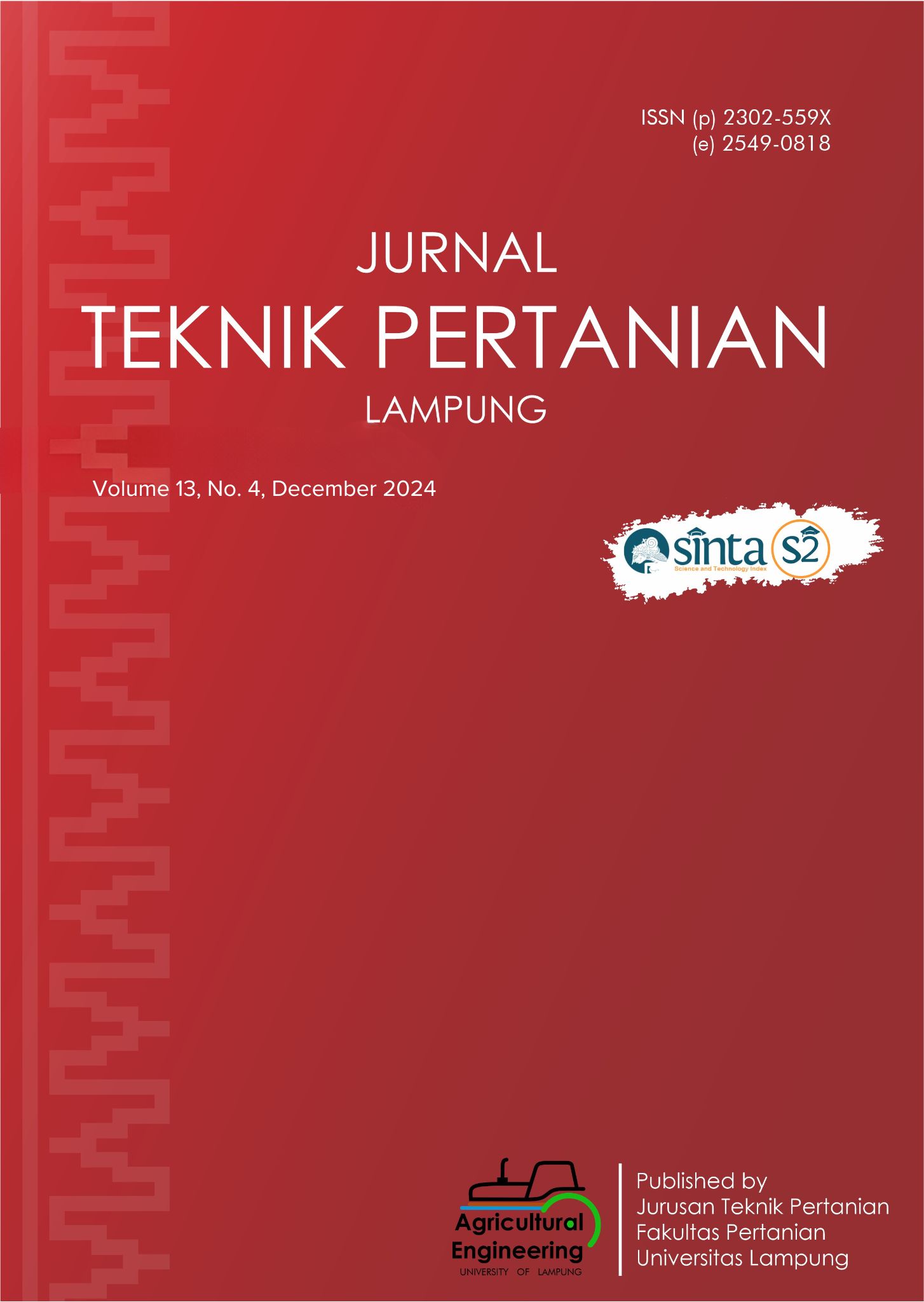Comparison of Two Fuzzification Algorithms (EC-pH and EC-pH Error Error Difference Fuzzifications) of Nutrient Solution Control in Plant Factory
DOI:
https://doi.org/10.23960/jtep-l.v13i4.1361-1371Abstract
Plant factory is a model of intensive indoor cultivation with microclimate conditioning and lighting. This research aims to develop a fuzzy-based control and monitoring system for TDS, pH, and EC parameters in hydroponic integrated with Internet of Things (IoT) technology. The research was conducted at the Laboratory of Bio-environmental Management and Control Engineering, Department of Agricultural Technology, Faculty of Agriculture, Universitas Jenderal Soedirman. The research results showed that the monitoring and control system using the Fuzzy control algorithm with EC and pH fuzzification and the Fuzzy control algorithm with error and error difference fuzzification were successfully implemented. The data obtained indicated that the Fuzzy control algorithm with error and error difference fuzzification performed better in terms of accuracy and energy efficiency. The Fuzzy control algorithm with error and delta error difference fuzzification was more accurate because a single set pint value used as a reference resulted in better control, and this algorithm also consumed less energy than the Fuzzy control algorithm with EC and pH fuzzification, with a difference of 30 minutes in EC control and 5 minutes in pH control.
Keywords: AB Mix Nutrient, Arduino, ESP8266, Fuzzy Logic Controller, Plant Factory.
References
Al-Gadri, P.F.Z. (2023). TA: Sistem Auto Light Dimmer pada Hidroponik Indoor Berbasis IOT menggunakan Fuzzy Logic Controller [Undergraduate Thesis]. Universitas Dinamika.
Anantama, A., Apriyantina, A., Samsugi, S., & Rossi, F. (2020). Alat pantau jumlah pemakaian daya listrik pada alat elektronik berbasis arduino uno. Jurnal Teknologi dan Sistem Tertanam, 1(1). https://doi.org/10.33365/jtst.v1i1.712
Ardiansyah, A., Naufalin, R., Arsil, P., Latifasari, N., Wicaksono, R.,Aliim, M. S., Kartiko, C., & Waluyo, S. (2022). Machine learning model for quality parameters prediction and control system design in the kecombrang flower (Etlingera elatior) extraction process. Processes, 10(7), 1-13. https://doi.org/10.3390/pr10071341
Binaraesa, N.N.P.C. (2017). Nilai EC (Electro Conductivity) berdasarkan umur tanaman selada daun hijau (Lactuca sativa L.) dengan sistem hidroponik NFT (Nutrient Film Technique). [Undergraduate Thesis]. Universitas Brawijaya.
Handi, H., Fitriyah, H., & Setyawan, G.E. (2019). Sistem pemantauan menggunakan blynk dan pengendalian penyiraman tanaman jamur dengan metode logika Fuzzy. Jurnal Pengembangan Teknologi Informasi dan Ilmu Komputer, 3(4), 3258–3265. Diambil dari https://j-ptiik.ub.ac.id/index.php/j-ptiik/article/view/4907
Lubis, H.R. (2020). Rancang bangun smart system ruang greenhouse berbasis IoT dengan menggunakan arduino UNO. [Undergraduate Thesis]. Fakultas Teknik, Universitas Islam Indonesia, Yogyakarta.
Marisa, M., Carudin, C., & Ramdani, R. (2021). Otomatisasi sistem pengendalian dan pemantauan kadar nutrisi air menggunakan teknologi NodeMCU ESP8266 pada tanaman hidroponik. Jurnal Teknologi Terpadu, 7(2), 127-134. https://doi.org/10.54914/jtt.v7i2.430
Nagase, K., Shiraki, T., & Iwasaki, H. (2016). Plant factory solution with instrumentation and control technology. Fuji Electric Review, 62(3), 160-164.
Paryanta, P., Wendanto, W., & Mulyani, P. (2021). Purwarupa deteksi pH dan ec larutan nutrisi hidroponik berbasis internet of things. Go Infotech: Jurnal Ilmiah STMIK AUB, 27(1), 1-12. https://doi.org/10.36309/goi.v27i1.139
Pertiwi, A., Kristianti, V.E., Jatnita, I., & Daryanto, A. (2021). Sistem otomatisasi drip irigasi dan monitoring pertumbuhan tanaman cabai berbasis internet of things. Sebatik, 25(2), 739-747. https://doi.org/10.46984/sebatik.v25i2.1623
Prayitno, W.A., Muttaqin, A., & Syauqy, D. (2017). Sistem monitoring suhu, kelembaban, dan pengendali penyiraman tanaman hidroponik menggunakan blynk android. Jurnal Pengembangan Teknologi Informasi dan Ilmu Komputer, 1(4), Article 4.
Rahman, M.F., & Yanti, F. (2023). Aplikasi logika fuzzy dalam optimisasi produksi mebel menggunakan metode Mamdani. Jurnal Informatika Multi, 1(3), Article 3
Ramson, S.R.J., Vishnu, S., Shanmugam, M. (2020). Applications of Internet of Things (IoT) – An overview. In 2020 5th International Conference on Devices, Circuits and Systems (ICDCS), 92–95. https://doi.org/10.1109/ICDCS48716.2020.243556
Sakamoto, M., & Suzuki, T. (2020). Effect of nutrient solution concentration on the growth of hydroponic sweetpotato. Agronomy, 10(11), 1708. https://doi.org/10.3390/agronomy10111708
Siskandar, R., Mandang, T., Hermawan, W., & Irzaman, I. (2023). Engineering of information monitoring system sensor reading data based on smart wireless using NVDIA Jetson Nano and Arduino Mega on agricultural spraying machines. Jurnal Teknik Pertanian Lampung, 12(4), 921-936. http://dx.doi.org/10.23960/jtep-l.v12i4.921-936
Sumarni E., Priswanto, Irayani, Z. (2022). Application of electrical conductivity (EC) for some potato varieties in the aeroponically seed production with Root Zone Cooling and Evaporative Cooling in Tropical Lowlands. Jurnal Teknik Pertanian Lampung, 11(2), 184-194. http://dx.doi.org/10.23960/jtep-l.v11i2.184-194
Susanto, S., Hikmayanti, H., & Indra, J. (2020). Implementasi fuzzy logic pada tambak ikan bandeng berbasis internet of things (IoT). Scientific Student Journal for Information, Technology and Science, 1(1), 26–32.
Thamrin, S., & Candra, O. (2023). Perancangan sistem pengontrolan dan monitoring pengaliran nutrisi pada tanaman hidroponik berbasis arduino secara otomatis. JTEIN: Jurnal Teknik Elektro Indonesia, 4(2).
Watabe, T., Nakano, Y., & Ahn, D.H. (2022). The effect of electrical conductivity on fruit growth pattern in hydroponically grown tomatoes. Crops, 2(3), 323-335. https://doi.org/10.3390/crops2030023
Wijaya, R., Hariono, B., & Saputra, T.W. 2020. Pengaruh kadar nutrisi dan media tanam terhadap pertumbuhan bayam merah (Alternanthera amoena voss) sistem hidroponik. Jurnal Ilmiah Inovasi, 20(1).
Downloads
Published
Issue
Section
License
- Authors who publish with this journal agree to the following terms:
- Authors retain copyright and grant the journal right of first publication with the work simultaneously licensed under a Creative Commons Attribution-ShareAlike 4.0 International Lice that allows others to share the work with an acknowledgement of the work's authorship and initial publication in this journal.
- Authors are able to enter into separate, additional contractual arrangements for the non-exclusive distribution of the journal's published version of the work (e.g., post it to an institutional repository or publish it in a book), with an acknowledgement of its initial publication in this journal.
- Authors are permitted and encouraged to post their work online (e.g., in institutional repositories or on their website) prior to and during the submission process, as it can lead to productive exchanges, as well as earlier and greater citation of published work (See The Effect of Open Access).
Jurnal Teknik Pertanian Lampung

JTEPL is licensed under a Creative Commons Attribution-ShareAlike 4.0 International License.

